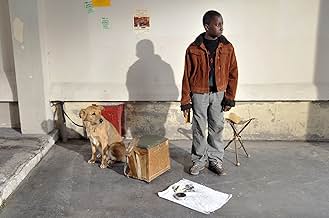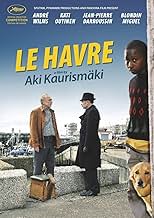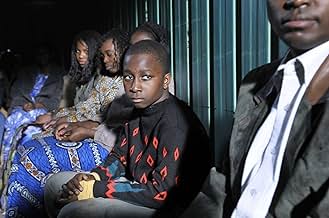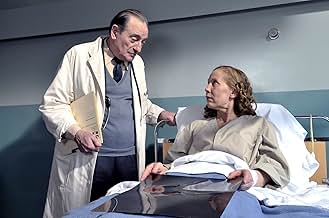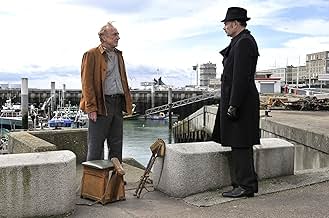VALUTAZIONE IMDb
7,2/10
24.753
LA TUA VALUTAZIONE
Quando un ragazzino africano arriva su una nave da carico nella città portuale di Le Havre, un anziano lustrascarpe prova pietà per lui e lo accoglie in casa propria.Quando un ragazzino africano arriva su una nave da carico nella città portuale di Le Havre, un anziano lustrascarpe prova pietà per lui e lo accoglie in casa propria.Quando un ragazzino africano arriva su una nave da carico nella città portuale di Le Havre, un anziano lustrascarpe prova pietà per lui e lo accoglie in casa propria.
- Premi
- 15 vittorie e 34 candidature totali
Quoc Dung Nguyen
- Chang
- (as Quoc-Dung Nguyen)
Little Bob
- Little Bob
- (as Roberto Piazza)
Recensioni in evidenza
In 1992, Finnish director Aki Kaurismaki directed LA VIE DE BOHEME, where he transplanted to Paris for a story of impoverished, failed artists on the cusp of society. A funny, sad film about art, love, and loss. Nearly twenty years later, Kaurismaki returns to France in LE HAVRE; while some of the humor remains, its story of the impoverished and dispossessed is even more affecting.
LA VIE... showed a painterly visual sense, all the more amazing that it was filmed in black and white. LE HAVRE boasts an equally striking visual sense, with scenes that seem to glow. That said, other elements of the production are less convincing - and at times. almost embarrassing. (For example, a group of black refugees are locked in a container crate for almost a week; when it's opened, no one's hungry or even concerned, and several are freshly shaved.)
LE HAVRE sets up the camera in a stationary spot - much like an old silent - giving the film a real resonance. But this affection for older filmmaking will be familiar for Kaurismaki fans; his silent, black and white JUHA uses the same minimalistic approach, with good results.
If you're willing to forgive certain production details and the dependence on melodrama, LE HAVRE is a feel-good story of how those of modest means can help those in desperate straits. (LE HAVRE itself was directed under low budget.) The film's humanism is its saving grace. While the filmmaking is occasionally awkward, there's still a lot to be admired here.
LA VIE... showed a painterly visual sense, all the more amazing that it was filmed in black and white. LE HAVRE boasts an equally striking visual sense, with scenes that seem to glow. That said, other elements of the production are less convincing - and at times. almost embarrassing. (For example, a group of black refugees are locked in a container crate for almost a week; when it's opened, no one's hungry or even concerned, and several are freshly shaved.)
LE HAVRE sets up the camera in a stationary spot - much like an old silent - giving the film a real resonance. But this affection for older filmmaking will be familiar for Kaurismaki fans; his silent, black and white JUHA uses the same minimalistic approach, with good results.
If you're willing to forgive certain production details and the dependence on melodrama, LE HAVRE is a feel-good story of how those of modest means can help those in desperate straits. (LE HAVRE itself was directed under low budget.) The film's humanism is its saving grace. While the filmmaking is occasionally awkward, there's still a lot to be admired here.
He's one of the directors (very few) there you recognize who's made the movie just after a couple of seconds. Kaurismäki has a tender view on shabby environments and shabby people. It has suited his Finland conception very well.
But it functions also in France and Le Havre, there you meet this shoe-polisher who tries to help a refugee boy. Not just the shoe-polisher, all working class people do.
It's a little miracle like every film in a sort of way is everywhere, but Kaurismäki takes it on without shame. And his environments and his tenderness seem to be universal. France is like Finland and the rest of the world.
But it functions also in France and Le Havre, there you meet this shoe-polisher who tries to help a refugee boy. Not just the shoe-polisher, all working class people do.
It's a little miracle like every film in a sort of way is everywhere, but Kaurismäki takes it on without shame. And his environments and his tenderness seem to be universal. France is like Finland and the rest of the world.
Protagonist is Marcel Marx, A Shoeshiner, who makes a peaceful living with his wife Arletty and a dog Laika in city of Le Havre. He incidentally meets an African boy, Idrissa, who is being sought by French authorities as illegal immigrant. Marcel opens his doors to the boy and helps him make his way to join his mother across the water in London.
Despite the complication of Arletty's terminal illness, about which Marcel is not aware, the snooping of grim-faced inspector Monet, and the machinations of the neighborhood snitch, with the help of neighbors and friends that Marcel was deeply in debt to forgive everything for Idrissa, Marcel tries to help the boy.
Kudos to Aki Kaurismäki, the director of Le Havre, for his directorial talent he has exhibited in this movie. No loose ends, characterization and usage of every character is excellent and has kept it very simple by all means.
Once in while you get to watch such an optimistic film that shows love, respect and tolerance for one another in a very simple and practical manner.
Follow Us @ : https://www.facebook.com/theworldmoviejournal
Reviews @ : http://theworldmoviejournal.wordpress.com/
Despite the complication of Arletty's terminal illness, about which Marcel is not aware, the snooping of grim-faced inspector Monet, and the machinations of the neighborhood snitch, with the help of neighbors and friends that Marcel was deeply in debt to forgive everything for Idrissa, Marcel tries to help the boy.
Kudos to Aki Kaurismäki, the director of Le Havre, for his directorial talent he has exhibited in this movie. No loose ends, characterization and usage of every character is excellent and has kept it very simple by all means.
Once in while you get to watch such an optimistic film that shows love, respect and tolerance for one another in a very simple and practical manner.
Follow Us @ : https://www.facebook.com/theworldmoviejournal
Reviews @ : http://theworldmoviejournal.wordpress.com/
This was one of the most visually stunning films I've ever seen. You could pause very nearly every shot and use it as screensaver or make a large print of it; that's how beautiful and well thought out they are.
Aki Kaurismäki evokes a sense of times past. He embraces the 'unreality' of his film, and the genre as a whole, and plays it up with great wit and art. As mentioned by previous reviews, he combines tragedy and comedy seamlessly into an extremely enjoyable and engaging film that doesn't try to pass itself off as life and as such engages on much deeper levels than its straightforward message or story would perhaps imply.
There are so many small details and well-thought out quirks here that keep your attention that it easily accommodates for my internet fried attention span, even while the director chooses not to openly deal with the electronic world. It's a decision indicative of the thoughtful and unique approach to the film; it aids both the storyline and the viewer's experience immensely. I was grateful and relieved to be taken away into a simpler and more honest world; both in the film's outward image, and within the story's universe. Its worth emphasising; this film doesn't try to masquerade as real life and as such allows for a much purer enjoyment. You don't have to worry about checking your expectations once the end credits roll.
Being beautifully shot may not have kept my attention for an hour and half, but the storyline and Kaurismäki's wit certainly did.
Aki Kaurismäki evokes a sense of times past. He embraces the 'unreality' of his film, and the genre as a whole, and plays it up with great wit and art. As mentioned by previous reviews, he combines tragedy and comedy seamlessly into an extremely enjoyable and engaging film that doesn't try to pass itself off as life and as such engages on much deeper levels than its straightforward message or story would perhaps imply.
There are so many small details and well-thought out quirks here that keep your attention that it easily accommodates for my internet fried attention span, even while the director chooses not to openly deal with the electronic world. It's a decision indicative of the thoughtful and unique approach to the film; it aids both the storyline and the viewer's experience immensely. I was grateful and relieved to be taken away into a simpler and more honest world; both in the film's outward image, and within the story's universe. Its worth emphasising; this film doesn't try to masquerade as real life and as such allows for a much purer enjoyment. You don't have to worry about checking your expectations once the end credits roll.
Being beautifully shot may not have kept my attention for an hour and half, but the storyline and Kaurismäki's wit certainly did.
This is a sweet, lightly intoxicating thing like a small glass of calvados under the wisteria in the evening. Kaurismaki has aged and his outcast and misfit characters aged with him, the quirks mellowed, the ferocious smoking toned down, the lines in the sometimes quietly astonished stone faces deeper, wearier, but imbued with almost ascetic serenity.
Some viewers have complained, why trivialize an actual problem in the manner of a fairy tale? A fair complaint for a problem perhaps more pressing than ever, especially in France and especially these days, with Sarkozi's desperate attempt to shore up votes for what looks like near-certain defeat in the upcoming elections by reverting to reactionary rhetorics from the far-right.
No, I believe the fairy-tale is the point. The idyllic neighborhood. The mannered caricatures of French people, with even the poorest having the time and fine sense of taste to leisurely enjoy their freshly baked baguette or glass of wine. The miraculous turn of events, explicitly acknowledged in the finale where kindness of this world is so overwhelming it even cures sickness. How could anyone miss this?
But a certain emptiness has always been of the essence for Kaurismaki, deliberate, designed emptiness.
The world is always flat to that effect, two-dimensional. The characters lack any conventional depth to speak of and do not really grow or learn lessons. By contrast, the plots of the films often exhibit a life of spontaneous motion, the objectives intentionally abstract, journeys across town, to America, in search of coffee and cigarettes. Motion for the sheer musical capacity of life to fill the quiet, the room in the heart to do so.
So it is always a variation of transient worlds centered in the stillness of the present moment that Kaurismaki has studied and consistently delivered. What is so remarkable is that he achieves this without any layering whatsoever, as a single flow.
This is his most Japanese film to date, even more concentrated flow than usual. Which is to say artificial nature that does not attempt to pass for the real thing but instead is empty space cultivated for beauty, a road-map for inner heart.
(I saw this together with the recent viral video KONY2012 and the contrast was amazing: that one, shameless artifice passing as nature, as truth, the real thing, contriving to motivate awareness several years after the fact and by selling merchandise, but was in truth both misinformed and morally dubious and even perhaps unwittingly manipulated agitprop in the service of shady foreign policy, while this one is simple, crisp, gracefully moral work, that does create awareness without any agendas.)
So it is very much the point that no one in the film is shown to wallow in misery, and most of the characters we meet would have plenty of reason to do so. Instead they enjoy this drink or meal together, whatever is at hand. And act with no complaint in the present moment to do what needs to be done. There is no meddlesome thought or proud ego to cloud the mind from the day's work, be it polishing shoes or helping out an immigrant kid.
This is the beauty of the thing: an idyll embedded with the purity of soul that gives rise to it and clear images only possible because of this cloudless eye.
The parting image is of a blossomed cherry tree gently rocking in the breeze, among the most traditionally Japanese images.
It encapsulates motion in stillness. The song of Zen.
Some viewers have complained, why trivialize an actual problem in the manner of a fairy tale? A fair complaint for a problem perhaps more pressing than ever, especially in France and especially these days, with Sarkozi's desperate attempt to shore up votes for what looks like near-certain defeat in the upcoming elections by reverting to reactionary rhetorics from the far-right.
No, I believe the fairy-tale is the point. The idyllic neighborhood. The mannered caricatures of French people, with even the poorest having the time and fine sense of taste to leisurely enjoy their freshly baked baguette or glass of wine. The miraculous turn of events, explicitly acknowledged in the finale where kindness of this world is so overwhelming it even cures sickness. How could anyone miss this?
But a certain emptiness has always been of the essence for Kaurismaki, deliberate, designed emptiness.
The world is always flat to that effect, two-dimensional. The characters lack any conventional depth to speak of and do not really grow or learn lessons. By contrast, the plots of the films often exhibit a life of spontaneous motion, the objectives intentionally abstract, journeys across town, to America, in search of coffee and cigarettes. Motion for the sheer musical capacity of life to fill the quiet, the room in the heart to do so.
So it is always a variation of transient worlds centered in the stillness of the present moment that Kaurismaki has studied and consistently delivered. What is so remarkable is that he achieves this without any layering whatsoever, as a single flow.
This is his most Japanese film to date, even more concentrated flow than usual. Which is to say artificial nature that does not attempt to pass for the real thing but instead is empty space cultivated for beauty, a road-map for inner heart.
(I saw this together with the recent viral video KONY2012 and the contrast was amazing: that one, shameless artifice passing as nature, as truth, the real thing, contriving to motivate awareness several years after the fact and by selling merchandise, but was in truth both misinformed and morally dubious and even perhaps unwittingly manipulated agitprop in the service of shady foreign policy, while this one is simple, crisp, gracefully moral work, that does create awareness without any agendas.)
So it is very much the point that no one in the film is shown to wallow in misery, and most of the characters we meet would have plenty of reason to do so. Instead they enjoy this drink or meal together, whatever is at hand. And act with no complaint in the present moment to do what needs to be done. There is no meddlesome thought or proud ego to cloud the mind from the day's work, be it polishing shoes or helping out an immigrant kid.
This is the beauty of the thing: an idyll embedded with the purity of soul that gives rise to it and clear images only possible because of this cloudless eye.
The parting image is of a blossomed cherry tree gently rocking in the breeze, among the most traditionally Japanese images.
It encapsulates motion in stillness. The song of Zen.
Lo sapevi?
- QuizThe character Marcel Marx, played by André Wilms, first appears in Vita da bohème (1992). Jean-Pierre Léaud also appears in both films, but as different characters.
- Citazioni
Marcel Marx: L'argent circule au crepuscule.
- ConnessioniFeatured in At the Movies: Cannes Film Festival 2011 (2011)
- Colonne sonoreMatelot
Performed by The Renegades
I più visti
Accedi per valutare e creare un elenco di titoli salvati per ottenere consigli personalizzati
- How long is Le Havre?Powered by Alexa
Dettagli
Botteghino
- Budget
- 3.850.000 € (previsto)
- Lordo Stati Uniti e Canada
- 611.709 USD
- Fine settimana di apertura Stati Uniti e Canada
- 26.363 USD
- 23 ott 2011
- Lordo in tutto il mondo
- 12.959.706 USD
- Tempo di esecuzione
- 1h 33min(93 min)
- Colore
- Proporzioni
- 1.85 : 1
Contribuisci a questa pagina
Suggerisci una modifica o aggiungi i contenuti mancanti


